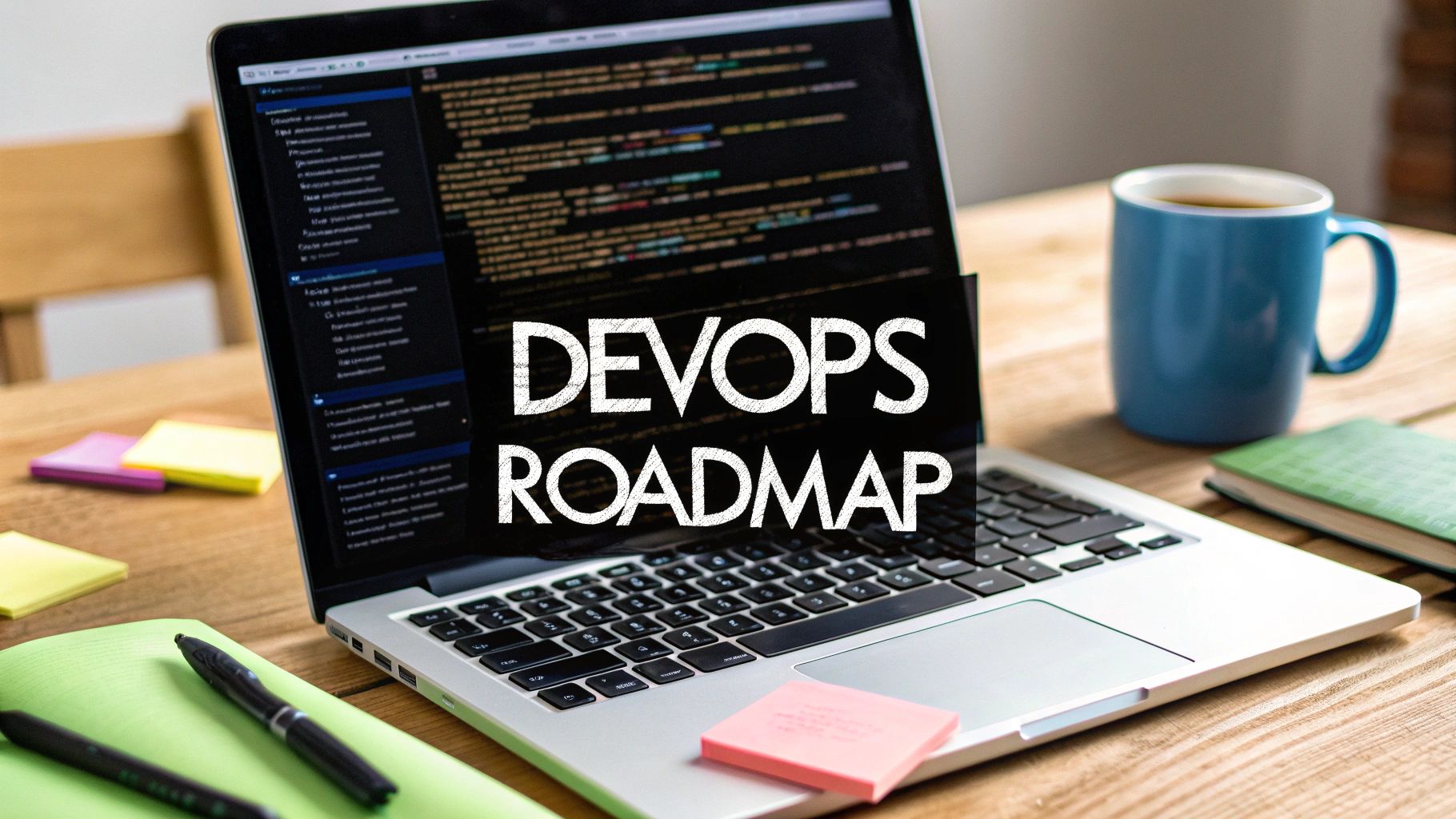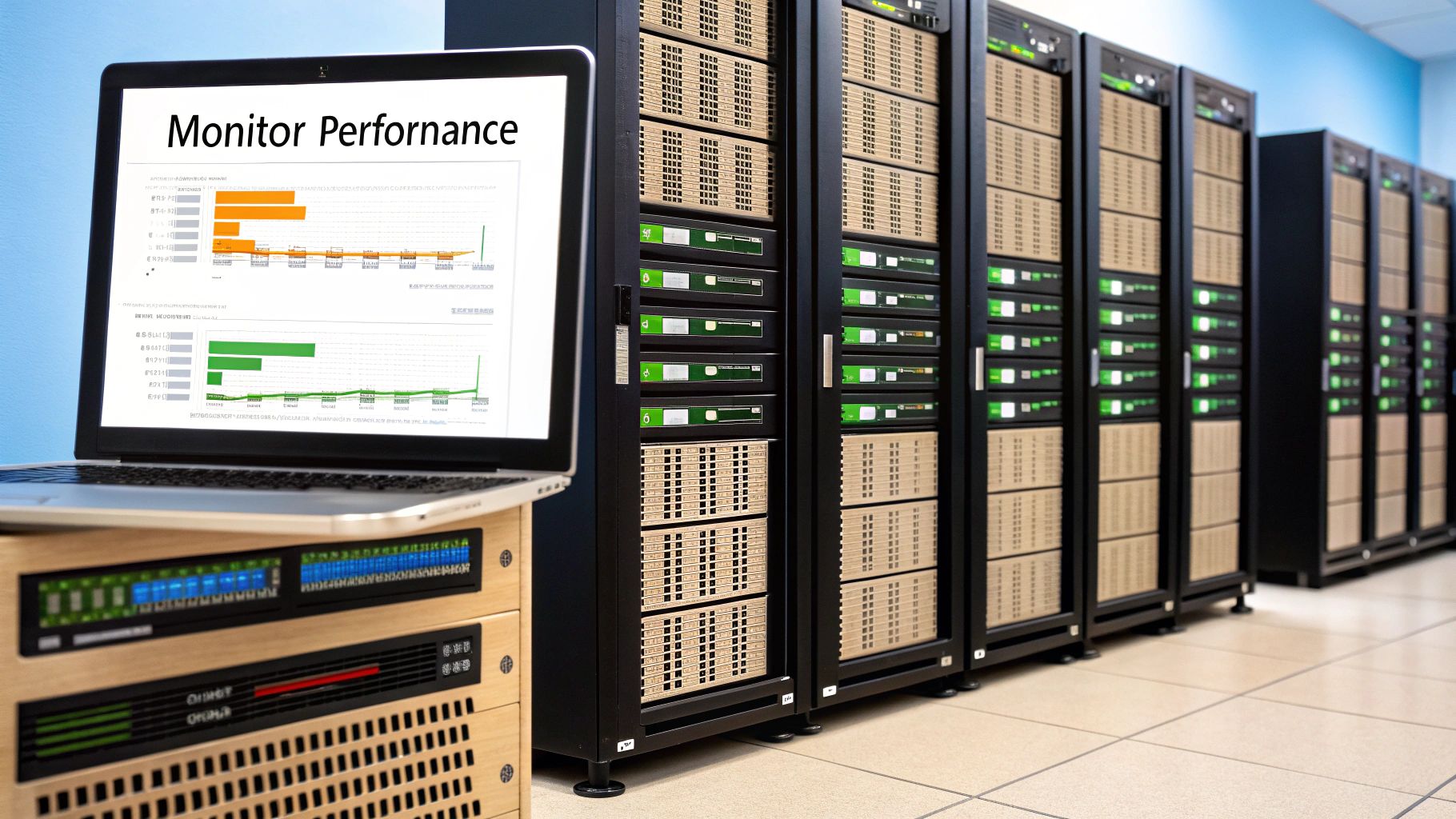 09.06.2025
09.06.2025
 09.06.2025
09.06.2025

Let's be straight, "DevOps" can sound like just another trendy tech term. But for business owners, especially those using Laravel development services, it's about tackling real-world issues. I've chatted with numerous business owners here in the UK, and many were initially skeptical. Once they saw how DevOps could solve their specific problems, they were completely on board. Traditional development often means long lead times for new features, poor communication between teams, and annoying bugs appearing in live applications. That's where a practical DevOps adoption roadmap comes in.
One of the core principles of DevOps is bridging the gap between development and operations teams. Imagine two highly skilled groups, each laser-focused on their own area, but without a shared understanding of the overall project. This can lead to friction and slow things down. DevOps encourages these teams to collaborate, share responsibilities, and streamline the entire process. This isn't simply about faster deployments; it's about building better software, faster. For example, a UK fintech firm I worked with managed to cut their deployment time from weeks down to just hours after implementing a DevOps approach.
This shift in mindset is especially important in the UK, a major player in DevOps adoption. In fact, 8.77% of companies using DevOps – about 18,950 businesses – are located in the UK, showing how widely it's being used across different industries. What's more, a whopping 99% of organizations using DevOps report a positive impact on their operations. This data really underscores the tangible benefits DevOps can offer. Want to delve deeper? Discover more insights on DevOps statistics. This growth aligns with wider trends like business modernization strategies, affecting everything from process improvement to tech choices.
Before building your DevOps roadmap, you need to take stock of your current situation. Look at your existing development workflows, team dynamics, and the technology you're currently using. Are slow releases a bottleneck? Are communication breakdowns a regular occurrence? Pinpointing these pain points will help you decide if your organization is ready for this change. As you start exploring DevOps solutions, you might also be interested in our web development services. Identifying these challenges helps you pick the right tools and strategies. This ensures your DevOps journey isn't just about adopting new tech, but about achieving real business advantages.

This screenshot from the Wikipedia page on DevOps really shows how everything's connected. Notice how continuous integration and continuous delivery are linked with things like infrastructure as code and monitoring. It’s a visual reminder that successful DevOps isn't about cherry-picking tools, but building a system where all the parts work together smoothly.
Think of it like this: DevOps is more about people than platforms. Imagine building a house where the architect and builder won't communicate. Chaos, right? That’s often what traditional development feels like. This section is all about building a culture that makes your Laravel DevOps adoption smooth and effective.
In my experience, successful DevOps transformations begin with finding your internal champions. And surprisingly, these aren’t always your managers. They're often the developers or operations folks already frustrated with the current way of doing things. They’re hungry for something better and become the driving force, getting everyone else excited and helping them adjust.
I once worked with a London agency where developers and operations were constantly at odds. Their champion ended up being a sysadmin passionate about automation. He became the bridge between the two teams, explaining the benefits and patiently addressing everyone’s concerns. Within six months, their working relationship had completely changed into a genuine partnership.
Let's be real: change can be unsettling. Some team members might worry about DevOps, thinking they’ll lose their jobs or their skills will become outdated. Address these fears directly. Emphasize that DevOps is about empowering everyone, not replacing them. Show how automation frees developers from tedious tasks, letting them focus on more interesting, strategic work.
Creating psychological safety is key. Encourage experimentation without fear of failure. Mistakes will happen—it's part of the process. Treat them as learning opportunities. This builds trust and lets your team try new things confidently. Also, regular communication and transparent updates on your DevOps progress are essential. This keeps everyone in the loop, reducing the anxiety that often comes with big organizational changes.

So, you’re ready to dive headfirst into DevOps. Great! But let's be honest, the sheer number of tools out there can be a bit dizzying. This part of your DevOps journey is all about picking the tech that actually moves the needle for your business, especially when you're working with Laravel development services. It's about resisting the urge to chase every shiny new gadget and focusing on what brings real value.
First things first, let’s break down the core tool categories. You’ll need a robust version control system. Git is the gold standard here, letting multiple developers collaborate seamlessly on the same codebase.
Then there’s CI/CD (Continuous Integration/Continuous Delivery). This is the engine of your automation, streamlining your testing and deployment pipelines. Jenkins, GitLab CI, and GitHub Actions are all popular choices.
Next up: monitoring and logging. These are your eyes and ears on your systems, giving you crucial feedback. Datadog and Prometheus are popular, but there's a whole ecosystem of tools to explore. And of course, we can't forget infrastructure management. Tools like Terraform and Ansible allow you to manage and provision your servers as code – a fundamental DevOps practice.
I’ve seen firsthand how businesses can go overboard, adopting every new tool that catches their eye. This leads to tool sprawl, making things way more complicated than they need to be, especially when you're just starting out with DevOps. My advice? Keep it simple. Focus on the tools that solve your immediate problems and fit neatly with your existing Laravel setup.
For example, I worked with an e-commerce platform built on Laravel. They were using a super complex and expensive monitoring system that generated tons of data they simply didn't use. We switched to a simpler solution, slashing their infrastructure costs by a staggering 40% and actually improving their reliability. This freed them up to focus on the data that mattered – the data that helped them improve the customer experience.
Choosing tools that work well together is essential. With Laravel projects, you'll likely be using PHP-specific testing frameworks like PHPUnit. Make sure your CI/CD system integrates smoothly with these. A common combo, for instance, might be Git for version control, GitLab CI for CI/CD, and Terraform for infrastructure.
Also, consider your team's experience. If your developers are new to certain tools, investing in training or opting for more user-friendly options might be a wise move. Remember, the goal is to simplify and streamline your workflows, not add unnecessary complexity.
Ultimately, successful DevOps adoption is about picking the right tools for the job and integrating them seamlessly into your existing workflows. This sets a strong foundation for long-term success.

This screenshot shows a typical GitHub repository. It's at the heart of so many CI/CD pipelines. See those green ticks? They're a small but powerful visual cue. They show your automated tests passed, giving you confidence in every code change.
A DevOps adoption roadmap without Continuous Integration/Continuous Delivery (CI/CD) is like a car without an engine. It might look impressive, but it won't get you anywhere. Let's explore how to build automated pipelines for your Laravel applications that actually deliver, improving reliability and banishing those late-night firefighting sessions.
I've seen too many businesses try to automate everything at once. It's overwhelming and often creates overly complex systems that nobody understands. My advice? Start small. Focus on automating your testing first.
Get those unit tests, integration tests, and end-to-end tests running automatically with every code commit. This foundational step is more powerful than you might think. Imagine catching bugs before they hit your customers.
I worked with a SaaS startup that used to dread their manual weekend deployments. By starting with automated testing, they gradually built a system that allowed confident daily releases. The impact on their team's stress levels and confidence was immense.
Once your automated tests are running smoothly, it's time to automate your deployments. This is where your CI/CD pipeline really shines. Think of it as a well-oiled conveyor belt, moving your code from commit to deployment without manual intervention.
Database migrations can be a real pain point. Laravel Migrations helps automate schema changes across different environments. Managing configuration differences between environments is another key area. Tools like environment variables and configuration management systems can prevent accidental overwrites and ensure consistency. You might also consider ERP system integration for a more streamlined data flow across your business.
Even with perfect automation, things can and will go wrong. That’s why robust monitoring is so important. Set up a monitoring system that alerts you to problems before your customers even notice them. This might include error tracking, performance monitoring, and even user behavior analytics.
A rollback plan is your ultimate safety net. Knowing you can quickly revert to a previous version provides the confidence to deploy frequently. I've seen rollback strategies save businesses from costly errors. An e-commerce site I worked with had a faulty deployment that completely shut down their checkout process. Their rollback plan got them back online within minutes, minimizing the damage.
Building a robust CI/CD pipeline isn't about checking boxes. It’s about empowering your team, reducing stress, and boosting the quality of your Laravel applications. It’s about creating a system that fosters trust in your deployment process, so you can deliver value to your customers faster and with more confidence.
Cloud migration isn't just about saving money; it's about unlocking the real potential of DevOps. It's about gaining the agility and flexibility you need to react quickly to market changes. I've personally witnessed how moving to the cloud has transformed businesses in the UK, and I want to share some practical advice to help you make the most of this shift.
Before even thinking about migrating, you need a crystal-clear understanding of your current setup. What dependencies do you have? Where are the performance bottlenecks? Do you have too much capacity, or not enough? An honest assessment is key. It’s like planning a road trip – you wouldn’t leave home without knowing your starting point and your destination. This groundwork helps you create a DevOps adoption roadmap tailored to your specific requirements.
Migration shouldn't bring your business to a screeching halt. I've seen migrations planned so poorly that they caused huge problems. Plan your migration in stages, focusing on critical systems first and testing thoroughly every step of the way. This minimizes downtime and keeps your operations running smoothly. Think of it like renovating your house – you wouldn't demolish every wall at the same time. You’d work room by room to minimize disruption to your daily life.
This shift to cloud-based solutions is a massive global trend, impacting the UK's DevOps market as well. Gartner predicts over 85% of organizations worldwide will be using cloud computing by 2025. Discover more insights on how the cloud is reshaping the business landscape. This underscores the increasing importance of cloud integration within a comprehensive DevOps strategy.
The cloud offers a wealth of services that can truly boost your DevOps capabilities. Think automated scaling, improved disaster recovery, and reduced operational overhead. I once worked with a UK manufacturing company that migrated their infrastructure to the cloud and slashed their management time by a whopping 60%. They were then able to use those resources for innovation and product improvement. It's like having a dedicated team managing your IT infrastructure, leaving you free to focus on what you do best.
Cloud costs can easily get out of hand if you aren't careful. Set clear budgets, monitor your spending closely, and optimize your resource use. Security is paramount in the cloud. Implement strong security measures right from the start and train your team on cloud-native security best practices. Don't treat security as an afterthought; it’s a fundamental part of your cloud migration strategy.
So, you’ve embarked on your DevOps journey with your Laravel project. You're automating deployments, rocking some impressive dashboards, and maybe even deploying multiple times a day. Feels good, right? But how do you really know it's making a difference to your bottom line? This is where measuring success goes beyond simply counting deployments and those flashy, but often meaningless, vanity metrics. Successful DevOps isn't just about speed; it's about delivering real business value.
Let's be real, your stakeholders aren't impressed by how often you deploy. They care about improved customer satisfaction, increased revenue, and reduced operational costs. Your DevOps roadmap needs to be tied to these outcomes. For example, if you're running an e-commerce site built on Laravel, a key metric could be the conversion rate on your checkout page. If your DevOps improvements lead to faster page load times and a smoother checkout, you can directly link those technical changes to increased sales.
I once worked with a UK-based online retailer obsessed with deployment frequency. They were deploying multiple times a day, but customer complaints about website errors were also skyrocketing. By shifting their focus to error rates and customer satisfaction scores, they uncovered bottlenecks in their automated testing. Improving the quality of their releases had a huge impact on customer happiness and, ultimately, their sales.
Effective measurement means gathering actionable feedback. This goes beyond automated system monitoring. You need to actively seek feedback from your team and your customers. Regular surveys, user testing sessions, and even informal chats with your customer support team can offer invaluable insights.
Identifying bottlenecks before they become major headaches is crucial. This might involve analyzing log files, monitoring system performance with tools like New Relic, or even A/B testing to understand the impact of code changes. I’ve seen companies use performance dashboards that track key metrics like response times, error rates, and user engagement in real time. This allows them to quickly address issues before they impact the customer experience.
Data without action is just noise. Your measurement framework should inform decisions about your DevOps evolution. This might mean scaling up certain capabilities, changing your strategy, or even recognizing when initial improvements have plateaued and a fresh approach is needed. For example, if you're seeing diminishing returns from automating certain tasks, it might be time to focus on improving team collaboration or implementing better monitoring practices.
I’ve seen businesses use data to make smart decisions about their DevOps investments. One company realized their cloud costs were out of control despite increased efficiency. By analyzing their cloud usage, they found areas to optimize resource allocation and reduce costs without impacting performance. This allowed them to reinvest those savings in other areas of their DevOps roadmap.
By focusing on metrics that truly reflect business value, gathering actionable feedback, and using data to make informed decisions, you can ensure your DevOps adoption genuinely improves your business and isn't just creating impressive-looking dashboards.
Think of adopting DevOps like a road trip, not a drag race. You don't floor it from the get-go. You start by making sure your car is roadworthy and everyone's on board with the destination. Build a solid foundation by focusing on a culture of teamwork and open communication before even thinking about which tools to use. I remember working with a London agency once – their whole DevOps transformation took off because everyone was genuinely excited about the change and understood the "why." If you're building your initial DevOps team, you might find some helpful resources on our startup solutions page.
Next, choose your tech stack wisely. Don't overwhelm your team with a dozen new tools all at once. Think of it like packing for that road trip – bring what you need, not everything you own. Focus on tools that work well with your existing Laravel development services and solve your most pressing problems. I once helped an e-commerce platform drastically cut their monitoring costs simply by streamlining their tooling. Less is often more, especially in the beginning.
Then, ease into continuous integration. Start by automating your tests. It's like checking your oil and tire pressure before hitting the highway. Then, gradually build out your deployment pipeline. This gives your team time to adapt and builds confidence in the process. I remember working with a SaaS startup that went from painful weekend deployments to smooth, daily releases – it was a game changer for them.
Speaking of changing the game, how do you know if your DevOps adoption is actually working? You need to measure the impact on your business outcomes. For tips on refining your automation efforts and tracking their success, check out this helpful article: How To Measure The Success Of Your Sales Automation Strategy. And finally, remember that DevOps is a journey of continuous improvement. Regularly assess your progress, be willing to change your plans, celebrate your wins, and learn from the bumps in the road. Never stop tweaking and improving. If you need some expert help with your Laravel development and DevOps transformation, feel free to reach out – we're here to help at ICT.